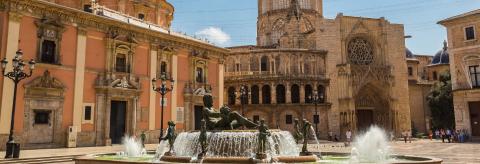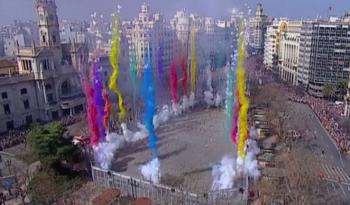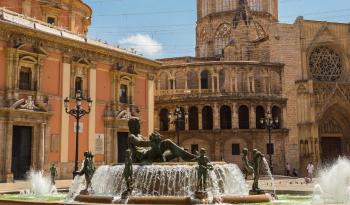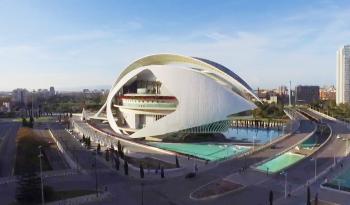
The historical centre of Valencia
The historical centre of Valencia is the inheritance of the diversity of cultures that funded and defined the city throughout the years. The majority of streets in the area known as Ciutat Vella, comprise the original limitis of the city. It is considered the historical, cultural and political centre of the city where many sites of touristic and interest can be found.
The most remarkable historical monuments throughout the city centre known as Ciutat Vella are the following:
The limits of the Ciutat Vella are marked by the Serrano Towers and the Quart Towers, which belonged to the Christian fort of the city. On the canvas of the towerd you can still appreciate the canon wholes from the Napoleonic wars. Both towers can be accessed by visitors and are offer an excellent outlook of the entire Ciutat Vella.
The Catedral de Valencia is located between the Plaze de la Virgen and Plaza de la Reina. It was consagrated in 1238 and built above the major mosque of the Muslim Marina. The Cathedral as it is nowadays, is product of multiple architectonic styles that have defined the building throughout the years. The Almoina Door (of roman style), the Obra Nova (italian renaissance), the San Jordi Chapel, the Apostles Door (french gothic), and the Micalet or Miguelete (of valencian gothic style, with public access to outstanding views of the city). We must also highlight the interior of the Cathedral, the Cimborrio and the renaissance apse paintings (with Musician Angels).
The Mercado Central, is a market renowned throughout Europe due to its Surface and architectonic style. At the present time, over 300 small commerces can be found at the market, with a variety of fresh products. The market is opened from 7:00 to 15:00, monday to saturday. We recomment you visit the site, with the possibility of buying fresh products in order to visit one of the restaurants surrounding the market, where they can cook your products for a reasonable price.
The Lonja de la Seda, declaires Human Patrimony by UNESCO, was built from 1483 to 1498. This building with gothic architectural style is named after the economic prosperity in Valencia during the peak of the silk industry. We recommend your visit to the site as it is one of the most unique civil gothic buildings of the Mediterranean.
La Seu is the oldest borough of Valencia and comprises almost completely the limits of what once was the roman Valentia. This borough is named La Seu, due to it being the location of the Cathedral, as well as of the headquarters of the Valencian Court and the Generalitat Valencian.
In the Plaza de la Virgen you can find access to many monuments such as the Basílica de la Virgen de los Desamparados, the Cathedral of Valencia, and the Palace of the Generalitat Valenciana. The fountain in this plaza, represents the river Turia, and it is at this site where the famous Flower Offering ends its trail in Fallas. Moreover, for over one thousand years, every thrusday at 12:00 o’clock, at the Apostles Door, the Tribunal of Las Aguas reunites. This institution, of islamic origins, is currently the most ancient a active legal institution in Europe.
In the Plaza de la Almoina, we find the biggest arqueological site in Valencia. The excavations began in 1985. We recommend your visit to the Almoina Museum, where you will be able to appreciate the evolution of the city since it was funded over 2000 years ago. Here, you can apreciate the diverse civilizations that colonized the area throughout history (Iberians, Romans, Visigoths, Muslims, Christians).
La Xerea is another borough from the Ciutat Vella. This space used to belong to the suburbs, outside the XI century arabian fort, where the Jewish quarters where found. In this borough you can find the Ceramic Musseum, the Patriarch Museum and the Cultural Center Bancaja. Special mention to the buildings in Calle de la Paz, architectonic proof of valencian modernism; as well as Calle Poeta Querol, which attracts passers-by due to its design shops.
El Pilar, another borough from the Ciutat Vella, also known as Velluter, was a key point for the silk industry. Here, you can find the Colegi de l’Art Major de la Seda, a XV century gothic museum available for visits, where we can find mosaics and paintings as well as information on the history of manufacturing and development of the silk industry.
San Frances, the biggest borough in Ciutat Vella, is named after the San Francesc Convent. Nowadays, the Cityhall square is located where the XIII convent used to stand. In this square, the Mascletás (a valencian firework show) take place square during Fallas.It is one of the centers of cultural development of the city. THe architectural style of the buildings is particularly interesting.
Finally, the Barrio del Carmen, where Apartments Downtown Valencia is located, is one of the oldest boroughs of the city with its origins dating back to the roman epoch. The singular urbanism of this area confires it one its identity trademark. The abundant palaces of the medieval era, as well as the churches, make walking through this borough a historical experience.
In this borough, we ough to highlight, among other streets that preserve the beauty and style characteristic of the medieval historical centre: Calle Caballeros, which historically used to be the residential area of the valencian nobility, and Calle Bolsería. Not to forget the Portal de Simat de Valldigna, which granted access to the morería; and the Plaza del Tossal, where the remnants of the XI century fort which can be visited.
We hope that, during your stay, you enjoy discovering for yourselves the singularity and beauty of the Ciutat Vella.


